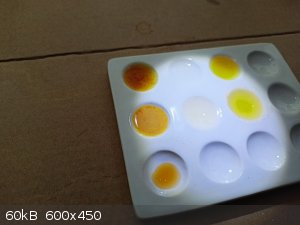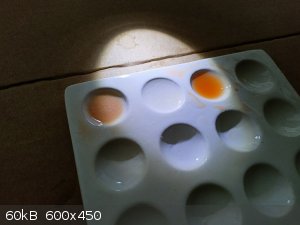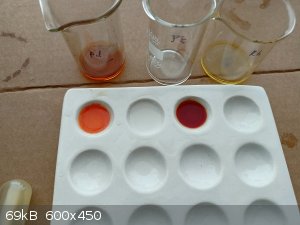Bedlasky
International Hazard
    
Posts: 1219
Registered: 15-4-2019
Location: Period 5, group 6
Member Is Offline
Mood: Volatile
|
|
Platinum metals experiments
Hi!
I recently visited my friend Fery and we did some experiments with Pd, Pt and Rh. Fery have some Pd and Pt standard solutions and Rh plating solution.
First we tried complexes with diacetyl dioxime and rhodanine. Pd and Pt forms brown/white precipitates with diacetyl dioxime, Pd also form brown
precipitate with rhodanine. On the photo - first row is diacetyldioxime, second row rhodanine.

Then we tried phenantroline. Pd and Pt precipitate as brown/white precipitate, while rhodium forms beautiful orange complex.

Next experiment was with KSCN. Pd forms orange complex, Rh forms red complex (similar in colour to Fe(III) and Mo(V)).

Rh can be precipitate in the presence of nitrite and potassium ions as light yellow preciptiate of potassium hexanitrorhodate(III).
![K3[Rh(NO2)6].jpg - 68kB](https://www.sciencemadness.org/whisper/files.php?pid=675869&aid=94269)
Pt can be precipitate with NH4Cl as yellow precipitate of ammonium hexachloroplatinate(IV).
![(NH4)2[PtCl6].jpg - 34kB](https://www.sciencemadness.org/whisper/files.php?pid=675869&aid=94271)
When I have some time, I revisit these metals for more experiments.
[Edited on 17-8-2022 by Bedlasky]
|
|
|
woelen
Super Administrator
        
Posts: 7977
Registered: 20-8-2005
Location: Netherlands
Member Is Offline
Mood: interested
|
|
Interesting to see experiments of these expensive and not common metals. Especially the hexanitrorhodate(III) is interesting. Is it really a
nitro-compounds, with :NO2 ligands, or is it a nitrito compounds, with :O-N-O liginds?
|
|
|
Fery
National Hazard
   
Posts: 990
Registered: 27-8-2019
Location: Czechoslovakia
Member Is Offline
|
|
Hi woelen, the Rh was as a solution for electroplating with concentration 10,0 g of Rh per 461 ml of solution. Very likely some form of Rh sulfate +
excess of acid. Some electroplating Rh solutions are phosphates and some contain more compounds. There are not more details on the bottle, just the
concentration of Rh and that the solution is for electroplating + the company which produced it.
We added a little of Rh solution into a test tube, then solid NaNO2 which soon produced tiny bubbles and foam which was hard to get rid of -
repeatedly heating over small flame and shaking helped only after few minutes. The tube was filled with NOx gases and certainly NO2 according gas
brownish color. The solution was clear. Then we added solid KBr (because we found it easily and we did not find KCl quickly enough which was very
likely hidden somewhere deeper and moreover Bedlasky told, that it is even better soluble than KCl). The addition of KBr produced the precipitate
shown on the picture. Previously we found sodium hexanitrocobaltate(III) and Bedlasky had an idea that Co(III) and Rh(III) are quite similar and that
Na₃[Co(NO₂)₆] is used for precipitation of K+ so we tried it with Rh instead of Co.
|
|
|
woelen
Super Administrator
        
Posts: 7977
Registered: 20-8-2005
Location: Netherlands
Member Is Offline
Mood: interested
|
|
Good point. Indeed I can imagine that Co(III) and Rh(III) have similar properties and can form similar complexes. I did not take that similarity into
account, when I wrote my previous post.
|
|
|
Fery
National Hazard
   
Posts: 990
Registered: 27-8-2019
Location: Czechoslovakia
Member Is Offline
|
|
Hi woelen, Bedlasky had that idea of similarity between Co(III) and Rh(III), not me 
We tried some ligands and then he went with the idea of potassium hexanitrorhodate(III) K₃[Rh(NO₂)₆]
I'm just guessing that the Na₃[Co(NO₂)₆] inspired him as we were checking what unrelated chemicals were available and I asked him what is
Na₃[Co(NO₂)₆] good for.
|
|
|
DraconicAcid
International Hazard
    
Posts: 4278
Registered: 1-2-2013
Location: The tiniest college campus ever....
Member Is Offline
Mood: Semi-victorious.
|
|
I really miss doing rhodium chemistry.....
Please remember: "Filtrate" is not a verb.
Write up your lab reports the way your instructor wants them, not the way your ex-instructor wants them.
|
|
|